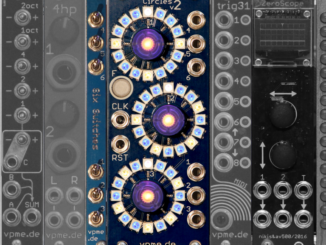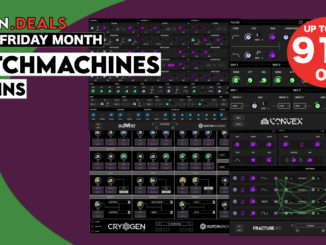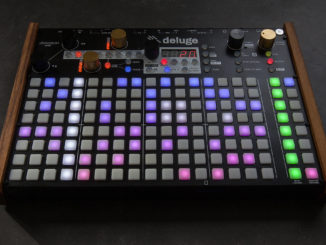Toneworks has announced a Summer Sale offering a 38% OFF discount on the Catalyst sequencer plugin for macOS and Windows.
Summer is plugin deal time. This year too. In my summary article, you will find out the best deals for this summer period. An update with the latest deals is coming soon.
Also onboard is Toneworks, the developer of the Catalyst sequencer plugin, which has also announced a summer sale. You can save 38% OFF on the plugin for a limited time. The developer asked me to feature the plugin on the Synth Anatomy website with a short presentation.
A Sequencer Plugin In A DAW?
Catalyst is a flexible sequencer plugin. Many people ask why you need a sequencer plugin when you have a full-featured DAW. The question is justified, and there are answers. Some DAWs are less extensive or less designed with sequencing in mind.
For example, Reaper. This is where Catalyst helps. Or you love the workflow of hardware sequencers, and you want a similar one in software form. Toneworks describes Catalyst as a sequencing powerhouse.
Toneworks Catalyst
It comprises five blocks: a monophonic sequencer, a harmonizer, an arpeggiator, a parameter sequencer, and a plugin host. Catalyst works with a loaded plugin or as a MIDI sequencer. In this case, you need to route the MIDI to another track.
All blocks can be used at the same time but also standalone. One click away from freedom.
The sequencing fun begins after loading the instrument plugin on the dedicated host page. On the sequencer level, you can set the root key first, so Catalyst will only play notes and chords in the chosen key. This is a very useful feature and a good starting point.
Then, you get your usual sequencer features, including pitch, velocity, and gate time per step. You can manually program the sequencer step per step or let the chance decide by using the devices next to the features.
Besides this, you can have up to five patterns with 32 steps each, octave control, rate, a wide range of sequencer directions including brownian, and step length. There is also a swing function for adding extra groove to your sequence. And if you want to work with longer notes or create bassline-style glued sequences, you can tie them together.
Chords A La Carte
The second block of Catalyst is the harmonizer, aka chord generator. Here you feed the harmonizer block with the notes from the step sequencer resulting in full, versatile chords. All this from single notes, and you don’t need to know music theory.
The harmonizer can be used flexibly. It allows you to customize the voicing, the number of notes in each chord, and more. So you can decide how complex your chords and the matching chord progressions will be. This can be easily set with the respective sliders.
And the previously determined root key is still the central point. It will only play the seven fundamental chords of it. But you can add 6th, 7th, and 9th notes to each chord, change the inversion, and more. Especially useful to experiment with chords to come up with new ideas.
Arpeggiator
Let’s continue with the arpeggiator block. The key feature of the Catalyst arpeggiator is its sequencer-like behavior. You can create your own patterns for it as you are used to with a classic sequencer. Unsurprisingly, it takes the signal from the chords from the harmonizer, which turns them into single notes again.
Alternatively, you can use it standalone and feed it with the notes from your DAW. Set each note’s pitch, velocity, and gate time right in the GUI. Plus, determine the steps of your arpeggiator, the rate, and the direction. You can also add repeat to the notes, and work with chord memory.
There is also a super handy transpose function with your MIDI keyboard where the black notes are the patterns (1-5) and the white do the transposition.
Besides the random function, you can also instantly create ladders with which you build arpeggios that go up or down with a button push. Also, here, you can trigger it from the DAW with notes—no need for hosting a plugin.
Parameter Automation
Last, Catalyst hosts a parameter sequencer with three dedicated lines (A, B, C) as an extra goody. Unfortunately, this is only limited to the internal plugins and cannot be routed to MIDI CC. Maybe in the future.
For each line, you can choose the automated parameter, the speed of the sequence (rate), the direction, and the steps (up to 32). The random function is particularly inspiring here because every dice roll creates new automation. Always different results without changing the main sequence.
Here is a Catalyst walkthrough video to see all this in action.
Toneworks has developed an easy-to-use creative sequencer with much potential. I hope the developer will add more features in the future, including ratcheting, probability, MIDI CC for parameter automation, etc.
Toneworks Catalyst is available now for 49€ instead of 79€ (38% OFF) during the summer sale. It runs as a VST, VST3, and AU plugin on macOS (Intel + native Apple Silicon) and Windows 10 or higher. A free trial is available on the website.
More information here: Toneworks









This is the best sequencer/arpeggiator to date! Toneworks did an amazing job. I hope that this plugin will be developed and improved for many years.